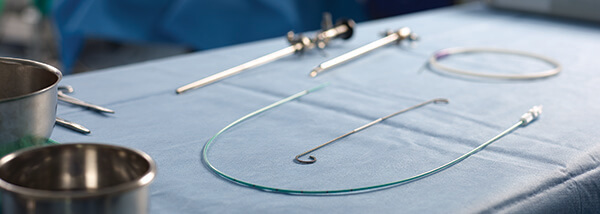It’s not every day that a medical device is conceptualised, designed, and manufactured with the understanding that it may be placed infrequently in patients. But that’s exactly what happened with the Resonance® Metallic Ureteral Stent.
At the outset of the Resonance stent’s development, we recognised that patients with extrinsic ureteral obstruction are often at risk for morbidity that is associated with frequent stent exchanges. With that in mind, our goal was simple: Create a product that can reduce the number of stent changes.
The Resonance stent’s coiled wire construction helps maintain urine flow even when the stent is under severe extrinsic compression. As a result, the Resonance stent is significantly more resistant to external compression than traditional polymer stents.¹ In addition, the Resonance stent’s radial strength allows it to remain indwelling for up to 12 months. This relatively long indwelling time minimises the need for multiple stent placements and the complications that are associated with frequent stent exchange.
Infrequent use can be a good thing and, as is the case with the Resonance stent, can equate with fewer stent exchange procedures.
We estimate the Resonance stent has potentially eliminated the need for more than 100,000² procedures since the stent was launched 11 years ago.
When a Resonance stent does have to be placed, we know we’re making a difference. This outside-of-the-box approach to innovation is just another example of how we continue to put the patient first.
Refer to the Resonance Metallic Ureteral Stent product page for the complete Instructions for Use.
¹Polcari AJ, Hugen CM, López-Huertas HL, et al. Cost analysis and clinical applicability of the Resonance Metallic Ureteral Stent. Expert Rev Pharmacoecon Outcomes Res. 2010;10(1):11-15.
²Estimate based on the most recent sales totals for the Resonance stent, the difference between the Resonance stent’s 12-month indwell time and standard 3-4 month indwell time for polymer stents (From Rosevear HM, Kim SP, Wenzler DL, et al. Retrograde ureteral stents for extrinsic ureteral obstruction: nine years’ experience at University of Michigan. Urology. 2007;70(5):846-850.), and the reported success rate for the Resonance stent (From Wah TM, Irving HC, Cartledge J. Initial experience with the Resonance metallic stent for antegrade ureteric stenting. Cardiovasc Intervent Radiol. 2007;30(4):705–710.).
